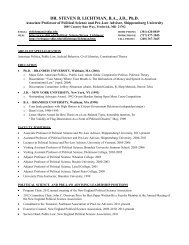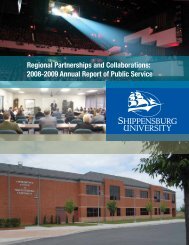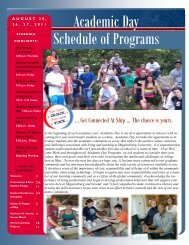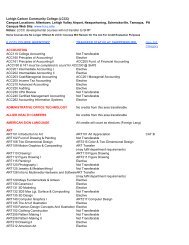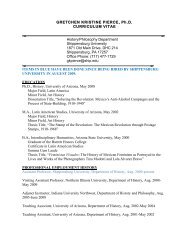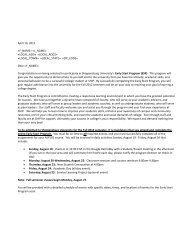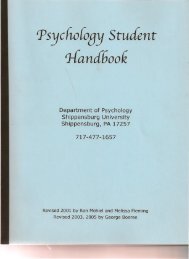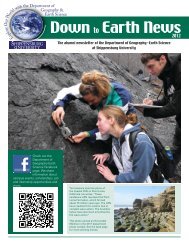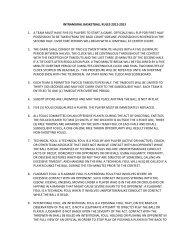Complete Issue - Shippensburg University
Complete Issue - Shippensburg University
Complete Issue - Shippensburg University
- No tags were found...
Create successful ePaper yourself
Turn your PDF publications into a flip-book with our unique Google optimized e-Paper software.
40 PROTEUS: A Journal of Ideasa state proceeded with a basin-wide adjudication.The Department of Interior voiced their objectionsto the over-reaching consequences of the proposedamendment in testimony before the Senate JudiciaryCommittee specifically as it applied to the “Wintersrights” of the nation’s tribes. 24In 1908, the U.S. Supreme Court ruled in Wintersv. U.S. that when the federal government reserves landfor purposes such as Indian reservations, forest reserves,military bases, parks, wildlife refuges, and other federaluses, the water necessary for the purpose of the landreservation is also retained by the federal government.Importantly in the generally arid western states where“first in time, first in right” is the basis of state waterlaw, the priority date for the federally reserved water isestablished as the date of the land reservation. As mostIndian reservations were established before statehood,Indian Winters rights are generally the most seniorwater rights in a state. 25The McCarran Amendment passed, unchanged, asa rider on the appropriation bill for the Departmentof Justice. Tribes would now have to argue before statejudges for the water rights promised them in theirtreaties with the federal government. Only a finaldecision by a state supreme court could be appealed bya tribe to the United States Supreme Court as an issueof federal law.In 1984, Idaho initiated the Snake River BasinAdjudication (SRBA) to settle all water rights claimsin the area of the state drained by the Snake River. 26Stretching from its headwaters in Wyoming to its exitfrom the state at Lewiston, the Snake River Basinincludes not only the Nez Perce Reservation, but alsoall of the Nez Perce aboriginal lands ceded by treaty.Those treaties specifically included the tribe’s retentionof the right to fish at their “usual and accustomedplaces,” even when off the reservation. To defend theirtreaty rights the Nez Perce would claim their reservedWinters rights.As a basin-wide adjudication, the Nez Perce tribewas compelled by the McCarran Amendment to assertand defend their Winters claims for instream water instate court. 27 In 1994, the tribe filed claims for 1,134water rights to support “fish habitat and channelmaintenance” 28 in accordance with the 1855 Nez Percetreaty:The exclusive right of taking fish in all the streamswhere running through or bordering said reservationis further secured to said Indians; as alsothe right of taking fish at all usual and accustomedplaces in common with the citizens ofthe Territory. 29The Nez Perce claims, if approved, would accountfor “105 percent of the average annual flow of theSnake, Clearwater, and Salmon Rivers combined.” 30Idaho Power Company, the State of Idaho, the PotlatchCorporation (a forest products company and Idaho’slargest private landowner), and a coalition of irrigationdistricts filed as interveners. Overnight, the politicaldistance between the tribe’s northern Idaho reservationand the irrigated agriculture center of southern Idaho’seconomic power structure shrank to zero.The SRBA JudgeAs the Snake River Basin Adjudication entered itsfifteenth year evaluating water rights claims, its longservingand well-respected presiding judge, DanielHurlbutt, announced his retirement. In February 1999,the Nez Perce tribe submitted a letter to the IdahoJudicial Council putting the state on notice as to thetribe’s expectation that the next SRBA judge musthave judicial experience and extensive a knowledge ofwater law, as well as no actual or perceived conflicts ofinterest. 31 In March 1999, interim SRBA PresidingJudge Barry Wood was appointed by the IdahoSupreme Court as permanent SRBA Presiding Judge.Eight months later, Wood handed down his decisionruling strongly against the Nez Perce’ claims. Indoing so, he went a significant step further than theprevious Nez Perce v. Idaho Power court, finding that the1893 opening of the Nez Perce Reservation to whitesettlement had diminished the reservation by the extentof all lands not currently owned by tribal members, orheld in trust for the tribe by the federal government,within the 1863 Treaty boundaries. Wood arrived atthis conclusion even while acknowledging existing caselaw did not support his decision. 32Judge Wood broke the fragile peace between thetribe and the people who had occupied their landsand used their water. His order found the variousNez Perce treaties and agreements did not imply theright to enough water for fish to live in, but only theright to fish, and that the sovereignty of the tribe overtheir homeland was reduced to the 17 percent of thereservation still in tribal hands after the allotment andtermination policies of the early 1900s. Both findingswere highly emotionally charged and even more highlyquestionable in their legal basis in the federal commonlaw. 33The tribe appealed the decision and in a separatefiling and sought the removal of Wood as SRBAjudge on the grounds his own and his familymembers’ ownership of several rights subject to SRBAjurisdiction constituted conflicts of interest. JudgeWood was removed by the Idaho Supreme Courtfrom his SRBA position. The court found the electionof Wood’s brother-in-law, Daniel Eismann, to theSupreme Court created an ethical conflict for theSupreme Court itself. Eismann was elected to the courtin a campaign against Justice Cathy Silak shortly afterSilak had authored the court’s opinion upholding thefederal government’s water rights in Idaho wildernessareas under the Winters doctrine. 34 During his electioncampaign, Justice Eismann had publicly stated hewould not recuse himself from ruling on water right



